There's nothing
wrong with your feet.

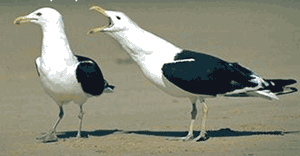

There's nothing wrong with your feet. |
 |
 |
 |
|
| |
Shoes
are
bad for you.
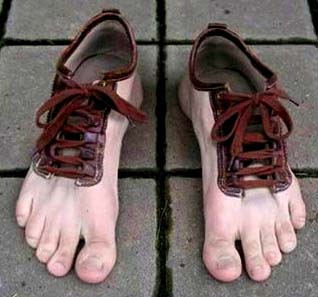 Here's
why. (link goes to the
now-famous New York Magazine article of April 21, 2008) Here's
why. (link goes to the
now-famous New York Magazine article of April 21, 2008) Have you read the New York Magazine article yet? Good. Now you know the basics. The main problem is this: your feet were designed to give you feedback from the ground. Shoes isolate you from that feedback. Shoes disable the ability of your feet to flex, to adjust, to balance your body, to move and to feel. Shoes turn your feet into prosthetic devices. The more "structured" and cushioned the shoe, the worse the problem. Your feet keep hitting harder and harder, trying to "find" the ground (it must be down there somewhere) and as a result we have all developed a very hard heel-strike method of walking and running. It's unnatural, perverse, unhealthy, and it causes injury, chronic pain, and tremendous wear and tear on the feet, knees, hips and spine. Get rid of the shoes, and suddenly your feet work the way they were designed to work. But in today's modern world, it's not practical to walk around barefoot, especially in urban environments. So I have been experimenting with various kinds of "nearly barefoot" shoes. 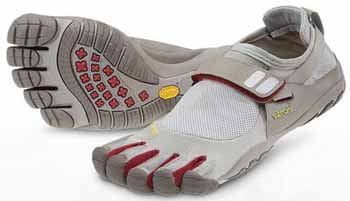 Basically,
if
you
follow
this
path,
you'll eventually be wearing Vibram "FiveFinger"
shoes (pictured to the left.) I'm not saying you
should start out with them, I'm just saying you'll
end up with them. You may do best by getting into
this gradually, as I did, starting with
moccasins and "water" shoes (also called River
Shoes, Aqua Socks, or Beach shoes.) Basically,
if
you
follow
this
path,
you'll eventually be wearing Vibram "FiveFinger"
shoes (pictured to the left.) I'm not saying you
should start out with them, I'm just saying you'll
end up with them. You may do best by getting into
this gradually, as I did, starting with
moccasins and "water" shoes (also called River
Shoes, Aqua Socks, or Beach shoes.) Unless you live in a very temperate climate, you'll want to get your FiveFinger shoes big enough to wear them with "toe-socks" for warmth. Socks also add just a bit of cushion and extra comfort, and I wear them with my FiveFingers all the time, even in the summer. It's simply more comfortable that way. Injinji is the go-to company for toe-socks. SmartWool now makes them, too. Both companies make an excellent sock. For your first pair of FiveFinger shoes, I recommend the "TrekSport" version. They are a little bit more padded in the heel area, and more comfortable than other versions, with an excellent fit, although they run just a touch smaller in the sizing so beware; try them on before you buy. The sole has excellent grip for hiking and trail running, with Vibram's thicker midsole for a bit of extra insulation for cooler weather and cushion for those of us who spend a good deal of time walking on concrete sidewalks. If you would rather lean toward less padding and get the most "barefoot" version for your first pair, consider the Speed, which is also renowned for being among the most comfortable FiveFinger shoes. Check out the Chia Lime drink and Pinole recipes in the right hand sidebar. update, May 5, 2013: A couple of new approaches to minimalist foot wear: Barefoot Running Sandals and Leming™ Footwear. Also, SmartWool is now making excellent five-toe socks. Hiking in FiveFinger shoes is great, even with a loaded pack -- provided you have done at least some training to strengthen your calves and feet. However, FiveFinger shoes aren't the best in heavy brush, off-trail bushwacking, wet conditions, and cold weather. Boots are better for that, but if you have been wearing minimalist shoes for a while, boots are almost always way too heavy, stiff, restrictive, isolating and uncomfortable. If only someone made decent "minimalist" boots. And behold: Lems Boulder, the "Barefoot" Boot and also the Belleville's "Mini-Mil" Minimalist Combat Boot. Something that I find interesting in current discussion among medical professionals: when someone suffers chronic sports injuries wearing "modern" footwear, it is either their own fault, or it is because they have a faulty body. When someone gets a sports injury wearing minimalist footwear, it is all the fault of the minimalist footwear! update: February 11, 2012: Injinji, who makes wonderful toe socks for wearing with FiveFinger shoes, has just discontinued their "Over The Calf" NuWool socks. I am bereft, I am despondent, I am discombobulated, bugged and crestfallen; those socks were the only thing standing between me and miserable, arctic Montana winter weather. They made the difference between being able to wear the Bormio FiveFinger boot in genuinely cold weather, and being forced to go "MonoFoot" again. What a bummer. update: October 24, 2011: I do a review of the Vibram FiveFinger Bormio men's boot. Finally, FiveFingers for Winter. update, May 12, 2011: Vibram FiveFingers announces new models for fall 2011: some genuinely warm insulated winter boots -- though only for women, some "dressy" models, some with laces, several with some real style. There's a men's zippered boot that is useful for cold weather, as it has leather instead of nylon between the toes. And the Speed, very popular in Europe, will finally come to the US. Here's several new models in some nice closeups. By the way, be very careful when looking for Vibram FiveFinger Shoes shoes on the net; counterfeit sites are proliferating. Many of them will simply take your money and then evaporate. Others will sell you cheap, useless Chinese knock-offs. While most of the counterfeit websites can look superficially legitimate, look a little closer and you'll spot the misspellings, the jumbled syntax, models and colors that aren't real, and a great opportunity for you to be ripped off. Back to some new cool shoes: Fila jumps on the bandwagon with some nearly-five-toes shoes; their Skeletoes is a bit softer and more casual than Vibram, more of a comfort / walking shoe. Teva FINALLY makes a minimalist sandal for hot weather: the "Zilch." update: January 19, 2010: Vibram FiveFingers rule! New FiveFingers Styles Spring 2011 including a new lace-up Bikila, a minimalist Jaya, and a "Cross Training" Komodo, which looks like it would be great for tennis, basketball, martial arts, or any active fast-moving sport. Finally, a FiveFingers for kids. Too bad the super-minimalist (and good looking) Speed isn't available in the USA. Bug Vibram about it; they'll respond. (Update; they did.) Also, Merrell and New Balance are finally getting into the act. update: December 15, 2010, Santa Edition: Vibram FiveFingers has several new models, including a Smartwool version, and a Trek Sport, which has gotten high reviews, and is a probably the best hiking shoe ever built, along with the KSO Trek, in leather, which provides a bit more protection from twigs and sharp poking things for your upper feet. (Vibram says that the leather actually breathes a bit better than the nylon, which seems to be true, in my experience.) I tried on the Flow, and had hopes for them as a winter shoe, but they are really designed for barefoot water sports use, and do not work with socks -- for my feet, anyway. Also, Injinji has now introduced a knee-high wool-blend toe sock, which is a huge help for colder weather. update: November 14, 2010 Kigo Footwear of Colorado is looking really good. A high-quality alternative to cheap water shoes, minimalist, starting around $50. update: Monday, February 1, 2010 From US News and World Report: Barefoot (or Barefoot-Like) Running May Guard Against Injury From "Nature" magazine: Tread Softly update: Saturday, November 21, 2009 Some really good news for feet; more nifty shoes that allow your feet to act like feet are evolved to act. (Be sure to read the January 9, 2009 post below on Winter Shoe Reviews: Ice Without Fear.) Here's the story, starting at the beginning: Tuesday, May 6, 2008 Among the joys of getting older; back trouble. I've been reading up on the idea that shoes are bad for you. And my bad back is driving me crazy. So I've decided to go "nearly shoeless" with minimalist footwear. A couple of mainstream shoe companies have come up with "barefoot shoes," which are designed to give your feet basic protection from cuts and bruises, but not to isolate you from the ground. I started doing research. One effort is the Nike "Free" which was designed for runners who want to benefit from running "barefoot." They are designed to be quite flexible. However, they are still highly padded and "constructed" (lots of "motion control" and "support" in there) and it's just more of the "same old" from the company that is probably most responsible for the entire phenomenon of chronic runner's injuries. If that weren't enough, the sole design catches and holds bits of gravel and drives you nuts. Stay away from these. They will NOT help you heal. A new company started off making a very simple (and cheap) walking moccasin, but turned into Teraplana, a big fashion shoe company that claims to sell shoes that meet the "barefoot" idea. Their original design was "Vivo Barefoot," which has now become trendy and expensive. Vibram designed the "FiveFinger" shoes for "barefoot" running, hiking and walking, and they've been so well received that they now have two new models, including one with some insulation for winter wear, thank goodness. But they are also expensive, hard to find, and a good fit is critical so shopping online is problematic. So I just pulled out an old pair of Nike "Aqua-socks" and started wearing them. Bingo. Very thin, super-flexible sole, enough protection from small sharp stones to keep your feet safe, and plenty of "feedback" from the ground. And cheap. They call them "Water Shoes" (or River Shoes or Beach Shoes) these days, and while some models are way overbuilt and shoe-like, many are basically a nylon upper, thin rubber soled moccasin. Perfect. Some good-looking current models are made by Teva (the "Proton") and by Speedo (the "Surfwalker.") And of course there's also moccasins. Minnetonka makes a bunch, some with leather soles, double leather soles for a bit longer life, and some with thin rubber soles for waterproofing and much longer life. All you need is something with a thin, extremely flexible sole and little to no padding, and there you go. Cabela's also carries moccasins. Ditto Eddie Bauer. And I almost forgot: Chinese slipper (Kung Fu) shoes. Black cotton uppers, thin (thought rather hard) rubber sole, $5. (They don't fit me at all.) So I've been walking around in moccasins and water shoes for a few weeks, and my back feels better. Much better. Wednesday, June 4, 2008 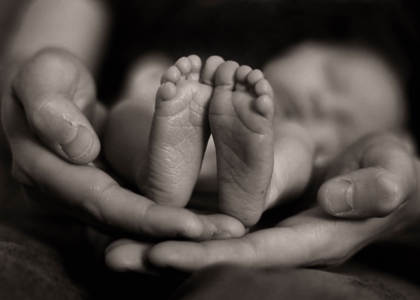 Hacking yourself:
the extended experiment in natural feet continues. Hacking yourself:
the extended experiment in natural feet continues.
After a month of going "nearly shoeless" -- that is, wearing very thin moccasins or water shoes -- I have a few things to report. 1. It seems to work. Starting from day one, my back is better, and has consistently been at a much lower pain level, in fact, mostly pain free. The evolution of the experiment: During the first two weeks, my feet and calves were very sore, but it was a "workout" sore, not a "dysfunction / injury" sore. That entire time, my lower back no longer hurt. I consider that to be a great trade off. My shoes were an old pair of Nike Aqua-socks (ugly, but a perfect fit and function) and a pair of double (leather) sole Minnetonka moccasins. Right off, I noticed that I had to re-learn how to walk. The pounding hard heel-strike that all modern shoes teach us has become deeply ingrained. But with moccasins, your body tells you with every single step that this doesn't work, so the learning curve is instant; you start walking in a new way immediately. Your use of calf and foot muscles is dramatically different, hence the "workout" soreness, which you can reasonably call "a good hurt." In just a few days, the new methods of landing on the outside edge and ball, rolling forward on the foot, flexing and pushing off with the toes -- this all becomes "automatic" quickly. It is, after all, they way your body was designed to function. The key here is the "feedback" between the sole of your foot, the muscles and skeletal structure, your body weight and balance, and the ground. Since you got rid of the isolation device called the shoe (which is designed to kill all feedback) you now have functioning feet again. Just listen to your feet and they will teach you how to walk, and they'll do it right now. Proprioception is good for you. At the two-week point, the soreness in my calves and feet had completely gone away. Day-to-day walking was (and is) perfectly comfortable. During weeks three and four, I noticed a few noteworthy things: while walking on dirt, grass, or any natural surface, the body does a very light heel strike, and it's never a problem. It is only on concrete or asphalt that you must be somewhat obsessive about "fox walking" (the term officianados use to describe the elegant, efficient rolling motion that completely removes any heel strike.) I notice now that I'm at about a 95% "Fox-walk" all the time, with no particular effort or thought, and only need to "work" at the last 5% on sidewalks. With that in mind, I added an old running-shoe insole (about 1.5mm of foam) to my water shoes, and that tiny bit of extra cushion got rid of "the concrete problem." It puts my 95% Fox-walk into a perfectly comfortable range for walking in urban environments, even in distances over five miles at a time on brick-hard asphalt roads. If I experiment at going back to "the old pound," my feet simply tell me it's a bad idea, so that little bit of cushion doesn't seem to go too far toward unhealthy isolation of the foot, and I haven't gone back to the old "pound." Minnetonka moccasins with the flexible, thin outer sole and a bit of innersole cushion seem to be a tiny bit more than you need for walking on concrete, but they are probably just fine in the long run and will get your feet "doing the job" at being alive and healthy. Ditto the Teva Proton, which I have ordered -- I'll review them after wearing. I have also ordered a pair of the Minnetonka side-gore moose hide, and will report once I've had a try with them. These should be helpful for situations where I need to be dressed in a "normal" fashion, more or less, and especially for cold winter weather. For summer and daily / casual wear, the various cheap water shoes I've tried work very well, but they seem to be so cheaply made that they won't last long. But in the long run, the price per wearing probably comes in at less than the "standard" expensive shoe. 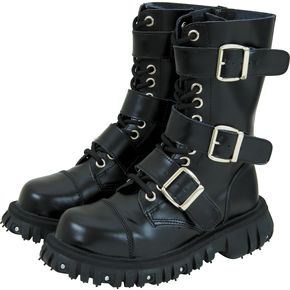 2. Now for the interesting part: I like it. 2. Now for the interesting part: I like it. The feeling I get while wearing extremely lightweight, thin, flexible shoes, is one of agility, aware balance, great "quickness" on my feet, and an ability to move around like I'm young again. I feel far more physically light. And, I find that my feet want to touch the ground in the same way that my hands want to touch things I see. Feet like to touch the ground. They like to flex. They want to feel. Satisfying that want creates a surprisingly intense body reaction; you start feeling better, immediately. Your feet become accustomed to touching, and, after a very short while, they won't settle for less. (Is it any wonder that little kids hate shoes so much?) As an experiment, I put on my pair of "lightweight" walking / hiking shoes by Merrel, the current state of the art in protection, cushioning, support, traction, and high-tech materials. When I first purchased them, I marveled at how lightweight and comfortable they were. Now, they make me feel like I've encased my feet in Novocaine-impregnated concrete blocks. Feeling my feet and toes immobilized was awful. I found myself stumbling, clumsy and hesitant, and I felt like my feet were yelling at me to "Get these Damn Things OFF! We HATE this!" (I suddenly remembered being one of those aforementioned shoe-hating kids.) In one month, my feet have learned just how perverse, bizarre, unhealthy, uncomfortable and downright weird "shoes" really are. I doubt that I will ever want to go back. Tuesday, July 15, 2008 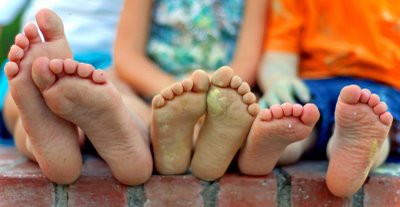 "Nearly barefoot"
shoe reviews. "Nearly barefoot"
shoe reviews. After wearing these things for a couple of months, I've some recommendations: First, almost all of the cheap, thin-sole "water shoes" for sale at various sporting goods mega-stores are well worth a try. They usually cost under $10, and that's a cheap experiment. And while they may be flimsy, the cost per wearing comes in at far less than a "real" shoe these days. Even the cheapest water shoe will last you several months, and they sell for about $6 a pair.
Wednesday, October 1, 2008 At the five-month point, my main worry is the impending winter weather. I simply can't stand wearing regular shoes now, but the lightweight nylon moccasins I've become accustomed to are likely to be far too cold for a Montana winter. The main loss of heat in the feet is actually through the sole, so an oversize pair of river shoes with wool socks and some extra innersole insulation may do the trick. Yes, they will be more padded and "isolating" from the ground, but if you live in a northern clime, you'd better be willing to adjust your body protection or you'll freeze solid. The Minnetonka Side-Gore Moose hide moccasins seem to be a good starting point for professional-environment winter wear. They even look good with a suit. Moose hide is very elastic and after trying on a pair, I bought them a full size smaller than I normally use. Even so, they have stretched out a bit and are comfortable with thick wool winter socks, so much that I may poke a small hole in the rolled edge and add a tightening lace, which you see in most moccasins anyway. As I mentioned earlier, remove the thick, stiff innersole to make them more flexible. I may look into trying some of the Minnetonka moccasins that are basically slippers, with soft, insulated linings and very flexible soles. They could be great for cold weather. Sierra Trading Post has (at the moment) a sale on the excellent Teva Proton. I bought two pairs, one in a size too large, for wear with extra heavy socks. We shall see how this goes when the snow flies. 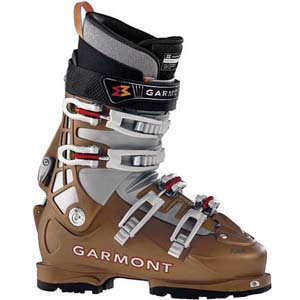 I am also
considering Wu-shu
and Tai-Chi
shoes. There's even high-top
wrestling boots out there, which might be
nice and warm if oversize enough for heavy wool
socks. I am also
considering Wu-shu
and Tai-Chi
shoes. There's even high-top
wrestling boots out there, which might be
nice and warm if oversize enough for heavy wool
socks. Next summer, when the weather warms up again, I will look into Capezio dance shoes. Some of them are darned near totally barefoot. Day to day, the "fox-walking" style has become so ingrained that I never even think about it. My heel strike is light and easy, the foot rolls forward naturally, and I can walk without compromise even on gravel roads with lots of sharp rocks. Did just that last night, in the dark. When the foot comes down on a sharp rock, it just rolls around and adjusts. It's pretty much effortless. My back has improved considerably. I move like I'm twenty years younger again. I feel better. Untie, unbuckle, unsnap and unlock those luggage trunks on your feet that you call "shoes." Put them aside and try on something that lets your feet act like feet. What have you got to lose, aside from pain? January 10, 2009 Winter Shoe Reviews: Ice Without Fear. After eight months, I can't imagine ever going back to "shoes." But winter in my neck of the woods (Montana) is daunting for the feet (as well as the rest of the bod) and it's not like I can run around in ballet slippers at forty below zero and expect to have all ten toes still attached at the end of the day. So insulation is the keyword here. However, after wearing minimalist shoes in the winter for a several months, I have found that you do NOT need nearly as much insulation as you may think. The entire key to foot warmth is circulation, and the key to circulation is MOVEMENT. Feet in super-flexible shoes MOVE. And they stay perfectly warm with surprisingly little insulation. Feet strapped into stiff boots get cold in minutes, and you need a ton of insulation to compensate. Much of the "barefoot" theory is predicated on the idea that "padding is bad." While there is some merit to that assertion, it's a moot point when you're tiptoeing through the glaciers. While you do need a little padding under the foot to prevent heat loss, it's surprising how little suffices. For cool weather (down to about freezing,) I have found that basic river/water/aqua shoes will do just fine, with one pair of medium-thick wool socks and a 2 or 3mm innersole. I simply use innersoles from my old walking and running shoes (adding them on top of the thin innersoles the shoes already have) and they serve, even in pretty darned cold weather. Until the snow started to fly, my "summer" river shoes did very well, if they were large enough to accommodate the extra innersoles and thicker socks. Once the snow and ice came, I found several better-insulated alternatives that have worked beautifully, shown below. Now for the actual walking experience. I have found that a modest amount of extra innersole does not hinder the "nearly barefoot" ideal, as long as the shoe -- especially the sole -- is extremely flexible. The flexing keeps your feet working like feet are supposed to work, keeps your toes gripping, your calves and ankles healthy. The flex is also the key to balance, "ground feel" and a remarkably improved security on ice and slippery snow. While walking in any of these shoes, I can feel the contours of the snow and ice under my soles, and I adjust as I walk. The foot seems to "wrap" over even the slipperiest surface for vastly improved traction. The former treachery of icy streets and sidewalks is a startlingly different experience when your feet can feel -- and adjust to -- every square millimeter of snow or ice underfoot. And the small-nub / sharp-sipe sole design that almost all thin-sole shoes use works far better than even the most "aggressive" lugged-sole waffle-stomper hiking boot. Add all that extra traction to vastly improved balance -- because the feet, ankles and legs can adjust and compensate -- and you have a totally unexpected result: much safer footwear for winter. A dear friend of mine had a terrible fall on the ice some years ago, with serious injuries resulting. After recovery, she resorted to wearing golf shoes -- with steel spikes -- whenever she had to venture outside on ice. Nobody begrudged her this, and it worked very well, as you can imagine. After a few bone-jarring falls of my own, I was starting to consider using golf shoes myself, especially after one of those falls caused a significant injury. I found myself being fearful of a bad fall, and I was mincing cautiously around on ice with a stiff, brittle paranoid posture, and it actually caused even more back problems. Imagine my surprise when these "nearly barefoot" shoes worked so well for winter wear. They make me feel young again; not exactly fearless, but competent and far more secure. I think that wearing extremely flexible shoes has improved my traction and balance to a huge degree By the way, George Washington got all of his winter troops out of shoes and into moccasins, because (with insulating inner wrapping made from scraps of wool blankets) they were far warmer, and they were also far more secure on ice. The men fell constantly when wearing shoes, and could not progress at all. In soft, flexible moccasins, they did very well, even when marching up frozen river surfaces, and their feet did not get frostbitten. My best winter "semi-barefoot" shoes are: 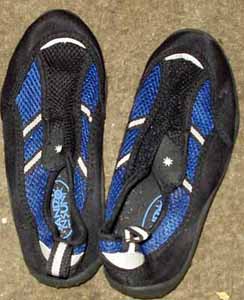 "Sand-N-Sun"
water shoes. $8 "Sand-N-Sun"
water shoes. $8 These come from Wallmart. These shoes are a little bit more "sturdy" than many water shoes, but still quite flexible and with a good sole design for grip on the ice. Mine are a full size too big, which was on purpose: with an additional 3mm thick innersole inside, and with two pairs of thick wool socks, they fit perfectly and are toasty warm, even walking on solid ice at fifteen below zero. The nylon mesh uppers are breathable enough to keep them bone dry, but they never feel cold even in the wind. Who would have thought that a pair of nylon mesh slippers with two pairs of wool socks would be adequate for a Montana winter? It may seem unlikely, but it works. My feet are actually MUCH warmer in these than they ever were in my big insulated leather waffle-stompers. These are my favorite sub-zero shoes, though I suppose almost any other sturdy water shoe in the right size (big enough for the added innersoles and two pairs of socks) would do as well, if they have a decent sole design. For trekking in deep snow, I just add gaiters, and these do as well as Sorels. And for lazing around the house, they are as warm and comfy as the thickest sheepskin slippers. It turns out that a pair of these will last for about two long, cold Montana winters, before the sole becomes smooth -- and they still grip quite well, because the sole flexes and conforms to the surface. For $8 (the 2010 price) they are hard to beat. 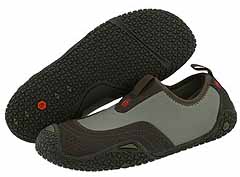 Teva "Proton."
$40 Teva "Proton."
$40The neoprene upper adds only a bit of insulation (a bit less than I'd hoped) but these are shoes that come into their own for active walkers, even in fairly cold weather. When I'm in motion in these shoes, they work beautifully. Warm, amazingly flexible, secure (the soles grip extremely well) and a confidence-inspiring elastic embrace of the foot add up to a great winter walking shoe. Because of the slightly snug fit, they can only take a thin pair of innersoles, but that suffices. Snow won't come in the top even if you are wading around in the deep, soft stuff. The action of walking pumps enough air through so they keep your socks fairly dry. However, I find that sitting around in these is not so great; they become clammy at sedentary rest (the neoprene doesn't breathe) and they stop insulating well. But they are wonderful for active use, and the waterproof neoprene construction is perfect for days when the snow is melting and sloppy. When the temperature drops into single digits though, these don't quite do the job. I have a pair of the Proton 4, pictured, and a pair of the Proton 3. Equally good either way. These also work well as summer hiking shoes, even for off-trail bushwhacking. As of 2010, Teva has discontinued the Proton and now makes the King Sling; it's a Proton with an adjustable nylon strap that keeps the shoe in place during the most vigorous activity. 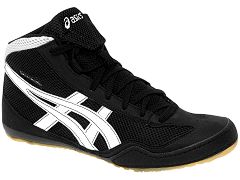 Asics "Matflex" Wrestling
Shoes. $50 Asics "Matflex" Wrestling
Shoes. $50I bought these large enough to fit with heavy wool socks (one thick pair) and they work beautifully in snow. The lightly-padded high-tops keep the snow out, they are permeable to stay dry (nothing is colder than damp socks) and they grip the ice very well. They flex nicely and have a good "ground feel." They need no extra innersole as they are already thick enough to insulate from the cold ground. The sole design has exceptional traction. They were, however, a bit tight and restrictive around the foot, even when loosely laced. So I removed all of the white plastic stripes from the sides -- it was a pain to do -- and they are now truly great winter shoes. They breathe better, flex better, stretch better, and feel great. May
2009 update:
It turns out that, for me, river shoes have been a great solution. They are pretty much all I wear now, with the only exception being Minnetonka side-gore moccasins for dressier occasions. Wallmart currently has good river/water shoes in stock. $7. They were formerly labeled "Sand N Sun" and are well-made, good fit, nicely ventilated and not too darned ugly. Lots of colors and styles for women, two colors for guys: the blue (shown above) and basic black with a few white bits. February, 2010 update. As I've mentioned, I live in a place where several hard falls onto cold-hard ice are an expected part of every winter. It's simply part of life here; you're going to fall sooner or later. But, since I switched to wearing "river shoes" (two winters now) I have not had one single fall -- not even a close call. The dramatically improved traction, balance and security of wearing "nearly barefoot" shoes has really paid off for me. It's a bit strange, walking around on the hard packed snow and ice, wearing little thin nylon moccasins, with feet that feel warm and comfy. I am more comfortable now than I used to be in insulated Sorels "packs." Granted, I wear thick wool socks with my river shoes, but still, it's all in the circulation, and hence, in the flex and movement. November, 2011 update. I finally bit the bullet last year and bought a pair of Vibram FiveFinger shoes (the KSO.) Love them. Bought a second pair (KSO Trek.) Love them, especially for hiking. Third pair: for formal wear (the men's "moc", in black leather.) Love them -- they look cool with a tux. (Now discontinued.) Fourth pair: the TrekSport, the most comfortable ones I have ever worn, and excellent for hiking and long-distance walking. Fifth pair: the Bormio, for cold weather winter wear. They are far warmer than any other FiveFinger shoe, and extend the FiveFinger season into all but the worst winter weather. If you've been wearing water shoes for a while, the transition to "FiveFinger" shoes is very natural and almost instant. They give an amazing feel of sure-footedness that is great for hiking and walking. I will admit that the cheapo water shoes aren't great for hiking on uneven terrain (I still like them better than "hiking" boots or shoes, though.) But the FiveFinger shoes are the best hiking footwear made -- period. You will feel like you have gecko feet. If you have balance problems these shoes are a Godsend. You do need to go to a store that stocks them for fitting, just to make sure that you get the right size. These are a bit expensive -- especially compared to water shoes -- but actually about the same price as the shoes I had been buying all my life. And in the long run, the total lifespan of a pair of FiveFinger shoes far exceeds any pair of "normal" shoes. The reason why: "normal" shoes break down quickly, lose their padding, their support and their comfort. So you end up with a pile of shoes that look like they have a lot of life left in them, but they are unwearable. (I had FIVE pairs of expensive hiking boots just taking up space in my closet, and NONE of them were usable for hiking anymore. They just broke down and sagged, and my feet hurt whenever I wore them on the trail.) FiveFinger shoes, on the other hand, feel great until the day that they wear completely through -- and then people use Gorilla Tape and Shoe Goo to get another few months out of them. They are just as comfortable (and functional) at the very end of their life as they are in the beginning -- in fact, even a bit more comfortable. I wear them with socks, the five-toes version made by Injinji: http://www.injinji.com/ They are extremely comfortable. They are the closest thing to going barefoot. They work. Walking around town is great; I have an even better body alignment than with river shoes or moccasins. I did not initially expect there to be a substantial functional difference in the way I walk and feel with these shoes -- after all, water shoes have been doing great things for me. But I was surprised, and convinced. The FiveFinger shoes really DO make a difference. Your feet act more like feet, and your body just feels better. Back country hiking is a revelation; you'll feel like you are experiencing the outdoors in a whole new way. You walk very quietly, you place your feet carefully instead of stomping through life, and at the end of the day you are far less tired. I'll never go back to boots. (Unless they are decent minimalist designs, like Lems or Belleville) Papa Vox homepage |
Hacking yourself:
An experiment in lowering the set-point as a means of safe, rapid, nearly-effortless weight loss. The miracle of medical massage. Shoe(less) links: "Born to Run: A Hidden Tribe, Superathletes, and the Greatest Race the World Has Never Seen." http://borntorun.org/ Birthday Shoes a great online resource Barefoot Running A good all-around source of general information and reviews of many "nearly barefoot" shoes. Barefoot Running Shoes a good place to start looking Vibram "FiveFinger" shoes great conversation starter, the best shoe made today Injinji "five toes" socks Feelmax - Finland Stylish, with ultra-thin soles and conventional styling Kigo Footwear made in Colorado Minnetonka Moccasin Terra Plana Vivo "Barefoot" shoes very nice but pricey Bagua Tai-Chi shoes not in the USA yet, but interesting Tarahumara food madness: Things Tarahumara have become very trendy and all the rage, thanks to "Born To Run." Here's the lowdown on two basic Tarahumara endurance / survival foods: Chia Lime drink: For one pint, mix
together:
Pinole: Buy a bag of Masa Harina
(corn flour treated with lime -- this is important --
for making tortillas and tamales.)
Spread 2 cups at a time on a large cookie sheet. Bake at 350 for 10 minutes, stir, and bake for another 10 minutes, until lightly browned. Cool completely, and store in airtight containers in the fridge. For a (very) basic trail snack, you can simply pour 1/4 cup or so of pinole into a pint jar, mix with water, shake for a while, and then slug it down. For flavor, add sugar and cinnamon. For a sit-down meal, you can simmer it until it thickens; probably a 4 to 1 ratio of water to pinole will do. Here's a basic trail-packable recipe
for:
Pinole Cocoa
Stir all ingredients
together to help avoid lumps. Mix with hot water and
whisk to make 16 to 24 ounces of hot cocoa. Stir
frequently while sipping.
Good stuff, and a "meal in a mug" when you are on the trail or in a big hurry. ...
|
|
The contents of this web page are merely opinion. Harmless words. Nothing more. |
||